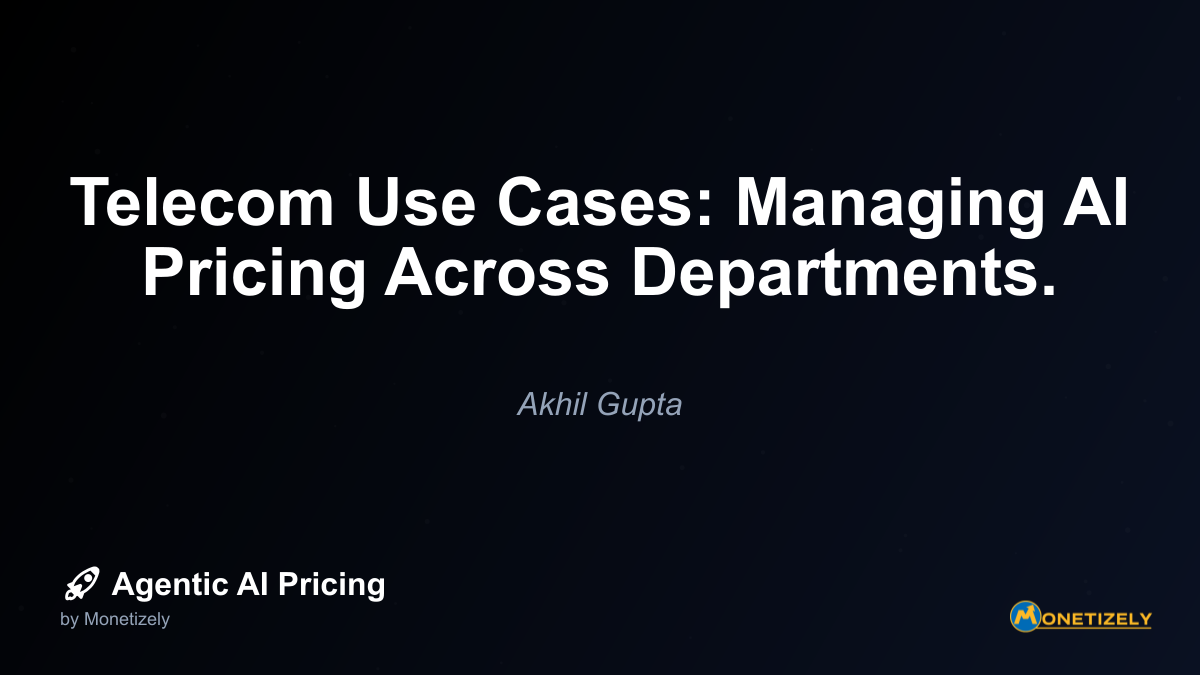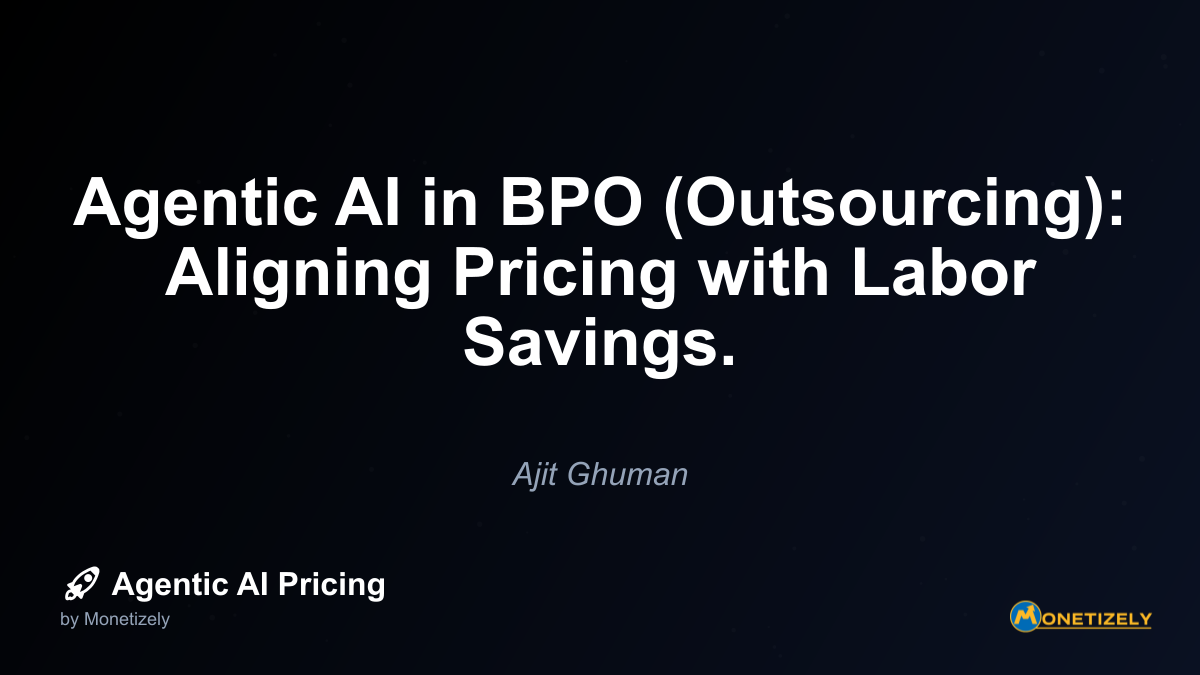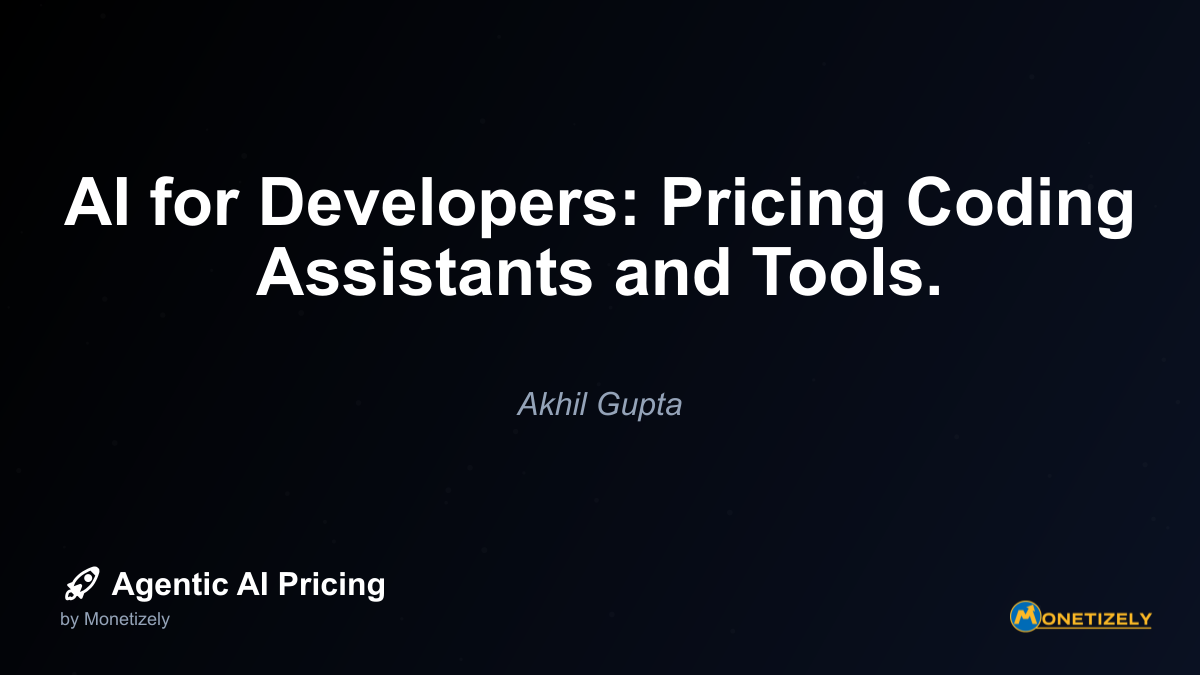· Akhil Gupta · Industry Insights · 9 min read
Telecom Use Cases: Managing AI Pricing Across Departments.
AI and SaaS Pricing Masterclass
Learn the art of strategic pricing directly from industry experts. Our comprehensive course provides frameworks and methodologies for optimizing your pricing strategy in the evolving AI landscape. Earn a professional certification that can be imported directly to your LinkedIn profile.

In today’s rapidly evolving telecommunications landscape, AI agents are no longer just experimental technology but essential business tools. Telecom giants worldwide are deploying AI solutions across multiple departments, creating a complex web of use cases, implementations, and pricing structures. What begins as isolated departmental initiatives often evolves into enterprise-wide AI strategies that demand cohesive pricing approaches.
The telecommunications sector presents a particularly fascinating case study for AI pricing strategies due to its dual nature: highly technical network operations combined with high-volume customer interactions. This duality creates diverse AI implementation paths with distinct value propositions, cost structures, and pricing considerations.
The Telecom AI Implementation Journey
Large telecom providers typically begin their AI journey with separate departmental pilot projects. Network operations teams might deploy AI for predictive maintenance or spectrum optimization, while customer service departments implement conversational agents for support inquiries. These parallel implementations create an organizational challenge: how to price, budget, and evaluate these disparate AI initiatives.
Network Operations: Technical AI Applications
Network operations represent the technical backbone of telecom companies. Here, AI agents serve specialized functions with significant technical complexity:
- Predictive maintenance systems that anticipate network failures before they occur
- Spectrum optimization algorithms that maximize bandwidth utilization
- Security monitoring agents that detect anomalies and potential threats
- Load balancing systems that distribute traffic efficiently
- Energy optimization tools that reduce power consumption across infrastructure
The value proposition for these AI implementations typically centers on cost reduction, efficiency gains, and infrastructure reliability. For example, a predictive maintenance AI might reduce downtime by 37%, translating to millions in saved revenue and improved customer satisfaction.
Pricing these technical AI implementations often follows traditional enterprise software models initially:
- Capacity-based pricing tied to network size or data volume
- Performance-based pricing linked to specific KPIs like downtime reduction
- Subscription models with tiered access to different AI capabilities
A network operations director at a major European telecom provider explains: “We initially approached AI vendors with our standard software procurement process. Each team negotiated separately, resulting in fragmented contracts and inconsistent pricing structures across similar AI technologies.”
Customer Service: High-Volume AI Interactions
On the customer-facing side, telecom companies deploy AI agents for entirely different purposes:
- Conversational support agents handling routine inquiries
- Personalized recommendation systems for service upgrades
- Customer churn prediction models for retention efforts
- Automated troubleshooting assistants for technical support
- Sentiment analysis tools for quality monitoring
These customer service AI applications are characterized by high transaction volumes and direct customer impact. Their value proposition centers on cost savings through automation, improved customer satisfaction, and increased sales through personalization.
The pricing models for these customer-facing AI implementations typically include:
- Per-interaction pricing based on conversation volume
- Outcome-based pricing tied to resolution rates or CSAT scores
- User-based licensing for agent-assisted AI tools
- Tiered subscription models with usage thresholds
A customer experience executive at a North American telecom giant notes: “Our initial AI chatbot was priced on a per-conversation basis, but as volume grew, this became prohibitively expensive. We needed to rethink our approach to make the economics sustainable at scale.”
The Convergence Challenge: From Departmental to Enterprise-Wide
As telecom companies mature in their AI implementations, a critical inflection point emerges. What began as separate departmental initiatives increasingly converge into an enterprise-wide AI strategy. This convergence presents both challenges and opportunities for pricing optimization.
Identifying the Convergence Trigger Points
Several factors typically trigger this convergence:
- Cost visibility and consolidation pressure from finance departments
- Technology standardization efforts from IT governance teams
- Cross-functional AI use cases that span departmental boundaries
- Enterprise-wide AI platforms that serve multiple business units
- C-suite recognition of AI as a strategic investment requiring cohesive management
A CIO at an Asia-Pacific telecom provider shares: “After two years of departmental AI experimentation, our CFO demanded a comprehensive review of all AI investments and their ROI. This forced us to develop an enterprise-wide perspective on our AI pricing and value realization.”
Common Pricing Inefficiencies in Siloed Approaches
Departmental AI implementations often create several pricing inefficiencies:
- Duplicate spending on similar AI capabilities across departments
- Inconsistent pricing models for comparable AI functionalities
- Missed volume discount opportunities due to fragmented purchasing
- Difficult ROI comparisons across departments using different metrics
- Vendor proliferation creating management overhead and security risks
These inefficiencies become increasingly apparent as AI deployments scale. What might have been acceptable during small pilot projects becomes financially unsustainable at enterprise scale.
Enterprise-Wide AI Pricing Strategies for Telecoms
Leading telecom companies have developed several approaches to optimize AI pricing across departments:
1. AI Capability Bundling
Rather than purchasing AI applications individually, forward-thinking telecoms bundle similar capabilities across departments:
- Natural language processing capabilities serving both customer service chatbots and internal knowledge management
- Predictive analytics engines supporting both network maintenance and customer churn prediction
- Computer vision technologies for both physical infrastructure inspection and retail store analytics
This bundling approach leverages economies of scale and creates negotiating leverage with vendors. It also facilitates internal cross-pollination of AI expertise and use cases.
A procurement director at a European telecom explains: “By consolidating our NLP requirements across six different business units, we negotiated an enterprise license that reduced our per-transaction costs by 62% while expanding access to the technology.”
2. Consumption-Based Enterprise Agreements
Many telecoms have shifted from departmental licenses to enterprise-wide consumption models:
- Compute-based pricing tied to processing resources rather than specific applications
- API call volume pricing with enterprise-wide pools rather than departmental allocations
- Data volume pricing consolidated across multiple AI applications
- User-based enterprise licenses that enable cross-departmental access
These consumption models provide flexibility while capturing volume efficiencies. They also align AI costs more directly with actual usage rather than projected needs.
3. Value-Based Portfolio Approaches
The most sophisticated telecom AI pricing strategies incorporate value-based elements across the AI portfolio:
- Outcome-based pricing components tied to specific business results
- Gain-sharing arrangements where vendors participate in documented cost savings
- Risk-sharing models with performance guarantees
- Innovation partnerships where vendors and telecoms co-develop solutions
A telecom CTO notes: “We’ve evolved from paying for AI technology to paying for AI outcomes. Our enterprise agreement with our primary AI vendor includes specific performance targets for network optimization, customer satisfaction, and operational efficiency.”
Implementation Framework: Building Your Enterprise AI Pricing Strategy
For telecom companies seeking to optimize their AI pricing across departments, the following framework provides a structured approach:
Phase 1: AI Inventory and Assessment
Begin with a comprehensive inventory of all AI implementations across the organization:
- Document all AI vendors and technologies currently in use
- Map pricing models and contract terms for each implementation
- Identify overlapping capabilities across departments
- Calculate total AI spend by category and business unit
- Assess value realization against original business cases
This assessment phase often reveals surprising insights about the total AI investment and opportunities for consolidation.
Phase 2: Value Alignment and Standardization
With a complete inventory in hand, focus on aligning AI pricing with business value:
- Standardize value metrics across similar AI implementations
- Develop consistent ROI methodologies for different AI categories
- Identify high-value vs. commodity AI capabilities
- Create internal pricing benchmarks for common AI functions
- Establish governance for new AI procurement
A pricing strategist at a telecom company shares: “We developed an internal AI pricing playbook that categorizes AI implementations by strategic value and provides negotiation guidance for each category. This gives our procurement team leverage in vendor discussions.”
Phase 3: Enterprise Consolidation and Negotiation
With standardized approaches in place, pursue enterprise-wide consolidation:
- Consolidate vendors where overlapping capabilities exist
- Negotiate enterprise-wide agreements leveraging total volume
- Implement consistent pricing models across similar AI functions
- Establish centralized AI procurement expertise
- Develop multi-year strategic vendor relationships where appropriate
Phase 4: Continuous Optimization
AI pricing should be viewed as dynamic rather than static:
- Regularly benchmark internal AI costs against market rates
- Monitor usage patterns across the enterprise
- Adjust enterprise agreements based on changing consumption
- Evaluate new pricing models as they emerge in the market
- Maintain flexibility for emerging AI use cases
Real-World Example: A Major Telecom’s AI Pricing Evolution
A Fortune 500 telecommunications provider’s journey illustrates this evolution in practice:
Initial State (2019): The company had 14 separate AI implementations across 8 departments, each with different vendors and pricing models. Total AI spend was difficult to calculate, with estimates ranging from $12-18 million annually.
Assessment Phase (2020): A cross-functional team conducted an AI inventory, revealing $16.4 million in annual AI spending with significant overlap in NLP and predictive analytics capabilities. They identified potential savings of 30-40% through consolidation.
Standardization Phase (2020-2021): The company developed standardized value metrics and ROI methodologies for AI implementations, revealing that some high-cost AI systems were delivering relatively low value, while other low-cost implementations showed exceptional returns.
Consolidation Phase (2021): The telecom reduced its AI vendors from 14 to 5 primary partners and negotiated enterprise-wide agreements with each. They implemented a hybrid pricing model combining:
- Base platform subscriptions covering core capabilities
- Consumption-based pricing for variable usage
- Performance incentives tied to specific business outcomes
Results (2022): Total AI spend decreased by 28% while expanding AI capabilities across the organization. The simplified vendor landscape reduced management overhead, and standardized metrics improved internal decision-making about AI investments.
A senior executive commented: “Beyond the cost savings, the real value came from creating a cohesive AI strategy. We shifted from departmental AI experiments to an enterprise capability that delivers consistent value across our business.”
Emerging Trends in Telecom AI Pricing
Looking ahead, several trends are shaping the future of AI pricing in telecommunications:
1. Embedded AI Economics
As AI becomes embedded in core telecom systems rather than standing alone, pricing models are evolving:
- AI-as-a-feature within broader platforms rather than separate products
- Outcome guarantees rather than technology licensing
- Value-sharing ecosystems where multiple parties contribute to and benefit from AI capabilities
2. AI Marketplaces and Exchanges
Some telecom companies are establishing internal AI marketplaces:
- Shared AI services available to all business units
- Internal chargeback mechanisms based on actual usage
- Capability catalogs with standardized pricing and SLAs
3. Customer-Facing AI Monetization
Leading telecoms are moving beyond internal AI use to monetizing AI capabilities directly:
- AI-enhanced services commanding premium pricing
- AI features as competitive differentiators
- New AI-powered products creating additional revenue streams
A product strategy director explains: “We’ve come full circle - from viewing AI as a cost center to seeing it as a value creator. Our enterprise AI pricing strategy now considers both the cost of AI and the revenue potential it creates.”
Key Takeaways for Telecom Leaders
For telecom executives navigating the complex world of enterprise AI pricing:
Start with value clarity. Understand how each AI implementation delivers business value before optimizing pricing.
Standardize before consolidating. Create consistent metrics and evaluation approaches before pursuing enterprise agreements.
Balance flexibility and efficiency. Enterprise-wide agreements should reduce costs without limiting innovation.
Consider the full AI lifecycle. Pricing strategies should account for ongoing training, maintenance, and evolution.
Leverage internal scale. Use the full volume of AI consumption across your enterprise as negotiating leverage.
Build AI pricing expertise. Develop specialized procurement capabilities for AI technologies and services.
Connect AI pricing to business outcomes. Whenever possible, align AI costs with the business results they deliver.
The telecommunications industry stands at the forefront of enterprise AI adoption, with its unique combination of technical infrastructure and customer engagement creating diverse AI use cases. By developing sophisticated, enterprise-wide approaches to AI pricing, telecom leaders can transform what began as departmental experiments into strategic capabilities that deliver sustainable competitive advantage.
As AI continues to evolve from experimental technology to business-critical infrastructure, telecom companies that master enterprise-wide AI pricing strategies will be positioned to maximize value while controlling costs – a critical capability in an increasingly AI-powered future.
Co-Founder & COO
Akhil is an Engineering leader with over 16+ years of experience in building, managing and scaling web-scale, high throughput enterprise applications and teams. He has worked with and led technology teams at FabAlley, BuildSupply and Healthians. He is a graduate from Delhi College of Engineering and UC Berkeley certified CTO.
Pricing Strategy Audit
Let our experts analyze your current pricing strategy and identify opportunities for improvement. Our data-driven assessment will help you unlock untapped revenue potential and optimize your AI pricing approach.




